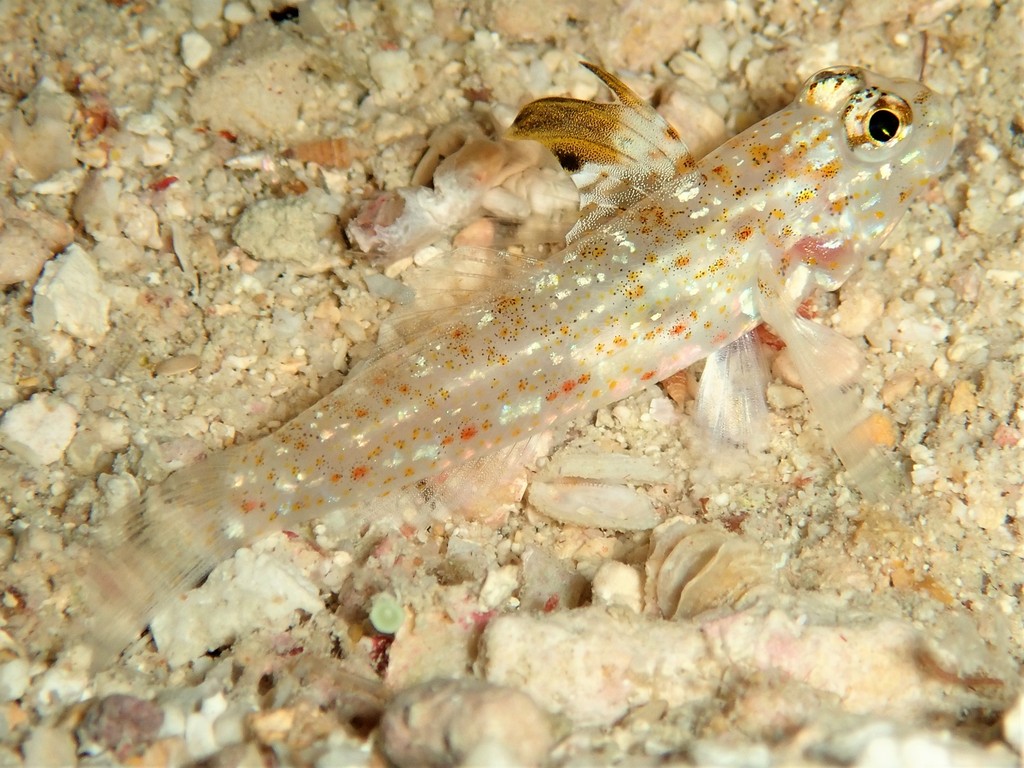FUSIGOBIUS MELACRON - (RANDALL, 2001)
Picture courtesy of: Alain Daoulas
Gobie des sables à épines sombres, Blacktip sandgoby,
Synonyme
Coryphopterus melacron Randall, 2001
----------------------------
Description
Dorsal spines (total): 6-7; Dorsal soft rays (total): 10; Anal spines: 1; Anal soft rays: 9; All dorsal and anal soft rays branched, the last to base; Pectoral fins rays: 19-21, (usually: 20), all rays except uppermost branched (second and lowermost rays unbranched in smaller paratypes); Pelvic fin rays: I,5; Branched caudal rays: 12; Upper unbranched caudal rays: 11-12 (usually: 12) the posterior 3 segmented; Lower unbranched caudal rays: 10-11 (usually: 11), the posterior 2 segmented; Longitudinal scale series: 27 (scales partially missing on most paratypes); Transverse scale series: 7; Circumpeducular scales: 12; Gill rakers: 2-3 + 8; Pseudobranchial filaments: 5-6 (usually: 6); Branchiostegal rays: 5; Vertebrae: 10 + 16. Body moderately elongate, depth: 4.75-5.2 in SL, and compressed, width: 1.25-1.35 in depth; Ventral part of head and chest broad and nearly flat; Head triangular when viewed from above, its length: 3.0-3.1 in SL; Snout length: 3.2-3.4 in head; Orbit diameter: 3.0-3.3 in head, the eye extending slightly above dorsal profile of head; Caudal-peduncle depth: 2.5-2.8 in head; Caudal-peduncle length 1.25-1.35 in head. Mouth moderately large, maxilla reaching to or nearly to a vertical at anterior edge of pupil, the upper jaw length: 2.35-2.5 in head; Mouth terminal or with lower jaw slightly inferior; Mouth oblique, the gape forming an angle of about 30° to horizontal axis of head and body. Scales ctenoid except those on chest, prepectoral area, and a few just above base of pelvic fins that are cycloid; Head naked, including nape except for its most posterior part above and slightly anterior to upper end of gill opening; No scales on fins except a few rows of scales smaller than those of body on base of caudal fin. Max. length: 3.5 cm SL. Depth range: 7 - 31 m.
Color
Light greenish gray, large dark bars and blotches as described above blackish, small spots and diagonal markings on head dark yellowish brown; scattered small greenish white flecks on head and body, one close-set series adjacent to row of small brown spots along lower side of body; Apical part of first dorsal fin black, the basal part dusky and blotchy white with dark brown and orangish spots forming horizontal rows; Spots in remaining median fins brownish orange.
Etymology
Fusigobius: from Latin, fusus = spindle + from Latin, gobius = gudgeon.
melacron: from Ancien Greek, mélas, mélanos = black + from Ancient Greek, ákron = extremity, peak. Referring to dark upper part of dorsal fin, its most characteristic color marking.
Original description: Coryphopterus melacron Randall, 2001 - Type locality: Northeastern coast at Tulamben, off wreck of U.S.S. "Liberty", on sand near small rock, quinaldine, J.E. Randall, 20 Oct. 1986, Bali, Indonesia, depth 30.5 meters.
Distribution
Indo-West Pacific: Andaman Sea and Indonesia east to Palau and Fiji, north to Ryukyu Islands, south to Kimberley (Western Australia), Queensland (Australia) and New Caledonia.
Biology
Inhabits sand-rubble bottoms next to reefs.
Similar species
Fusigobius signipinnis (Hoese & Obika, 1988) - Reported from New Caledonia - Link to the species (here).
Fusigobius signipinnis (Hoese & Obika, 1988) - Reported from New Caledonia - Link to the species (here).
